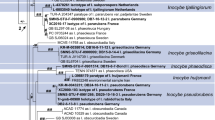Abstract
A study of the types of two species of Tricholomopsis described by C. H. Peck, T. flavescens and T. sulphureoides, revealed that their ITS sequences differ clearly from each other and from previously studied European species. The species T. osiliensis described from Estonia is a synonym of T. sulphureoides. Because both type collections were mixed, lectotypes were designated for each.




Similar content being viewed by others
References
Abarenkov K, Nilsson RH, Larsson K-H, Alexander IJ, Eberhardt U, Erland S, Høiland K, Kjøller R, Larsson E, Pennanen T, Sen R, Taylor AFS, Tedersoo T, Ursing BM, Vrålstad T, Liimatainen K, Peintner U, Kõljalg U (2010a) The UNITE database for molecular identification of fungi – recent updates and future perspectives. New Phytol 186:281–285
Abarenkov K, Tedersoo L, Nilsson RH, Vellak K, Saar I, Veldre V, Parmasto E, Prous M, Aan A, Ots M, Kurina O, Ostonen I, Jõgeva J, Halapuu S, Põldmaa K, Toots M, Truu J, Larsson K-H, Kõljalg U (2010b) PlutoF – a Web Based Workbench for Ecological and Taxonomic Research, with an Online Implementation for Fungal ITS Sequences. Evol Bioinform 6:189–196
Holec J (2012) Tricholomopsis osiliensis (Basidiomycota, Agaricales), recently described from Estonia, found in Slovakia. Czech Mycol 64(1):93–100
Holec J, Kolařík M (2012) Tricholomopsis in Europe — phylogeny, key, and notes on variability. Mycotaxon 121:81–92
Katoh K, Standley DM (2013) MAFFT multiple sequence alignment software version 7: improvements in performance and usability. Mol Biol Evol 30(4):722–780
Matheny PB, Curtis JM, Hofstetter V, Aime MC, Moncalvo J-M, Ge Z-W, Yang Z-L, Slot JC, Ammirati JF, Baroni TJ, Bougher NL, Hughes KW, Lodge DJ, Kerrigan RW, Seidl MT, Aanen DK, DeNitis M, Daniele GM, Desjardin DE, Kropp BR, Norvell LL, Parker A, Vellinga EC, Vilgalys R, Hibbett DS (2006) Major clades of Agaricales: a multilocus phylogenetic overview. Mycologia 98(6):982–995
Murrill WA (1914) Agaricaceae. N Am Fl 10(1):1–76
Peck CH (1872) Report of the Botanist [1869]. Ann Rep Reg NY St Mus 23:27–135
Peck CH (1873) Descriptions of new species of fungi. Bull Buffalo Soc Nat Sci 1:41–72
Peck CH (1874) Report of the Botanist [1872]. Ann Rep Reg NY St Mus 26:35–91
Peck CH (1891) Report of the Botanist [1890]. Ann Rep Reg NY St Mus 44:17–187
Rambaut A (1996) Se-Al: Sequence Alignment Editor. Available at http://tree.bio.ed.ac.uk/software/
Ronquist F, Teslenko M, van der Mark P, Ayres DL, Darling A, Höhna S, Larget B, Liu L, Suchard MA, Huelsenbeck JP (2012) MrBayes 3.2: efficient Bayesian phylogenetic inference and model choice across a large model space. Syst Biol 61(3):539–542
Singer R (1939) Phylogenie und Taxonomie der Agaricales. Schweitz Z Pilzk 17:52–57
Singer R (1943) Das system der Agaricales III. Ann Mycol 41(1):1–189
Singer R (1951) The Agaricales in modern taxonomy. Lilloa 22:1–832
Smith AH (1960) Tricholomopsis (Agaricales) in the Western hemisphere. Brittonia 12:41–70
Swofford DL (2002) PAUP*. Phylogenetic Analysis Using Parsimony (*and Other Methods). Version 4 beta 10. Sinauer Associates, Sunderland
Thiers B (2015) (continuously updated) Index Herbariorum: A global directory of public herbaria and associated staff, New York Botanical Garden’s Virtual Herbarium. http://sweetgum.nybg.org/ih/ Last accession: 18/03/2015
Vauras J (2009) Tricholomopsis osiliensis, a new agaric species from Estonia. Folia Cryptog Estonica 45:87–89
Vauras J, Saar I, Voitk A (2012) Comparison of European Tricholomopsis osiliensis with putative Tricholomopsis sulfureoides of Newfoundland. Omphalina 3(5):9–11, Available at: http://www.nlmushrooms.ca
Voitk A (2011) Tricholomopsis of Newfoundland and Labrador. Omphalina 2(7):6–9, Available at: http://www.nlmushrooms.ca
Acknowledgments
The authors are indebted to the directors and the curators of the fungaria NYS, TU, and TUR-A for the loan of the specimens. We are grateful to Edgar Lickey for sending us the first sample from the holotype of Agaricus sulphureoides, and R. Greg Thorn for supplying reference material difficult to obtain. We are obliged to Lorinda Leonardi from the New York State Museum for the images of Peck’s original illustrations and the photos of the type collections. This work was supported by the institutional research funding IUT (IUT20-30) of the Estonian Ministry of Education and Research, and by the European Union through the European Regional Development Fund (Center of Excellence FIBIR).
Author information
Authors and Affiliations
Corresponding author
Rights and permissions
About this article
Cite this article
Saar, I., Voitk, A. Type studies of two Tricholomopsis species described by Peck. Mycol Progress 14, 46 (2015). https://doi.org/10.1007/s11557-015-1068-5
Received:
Revised:
Accepted:
Published:
DOI: https://doi.org/10.1007/s11557-015-1068-5




